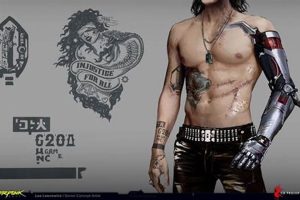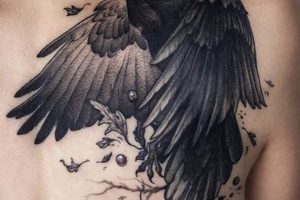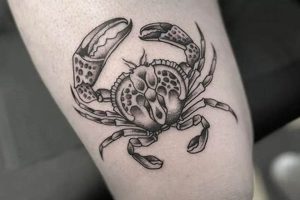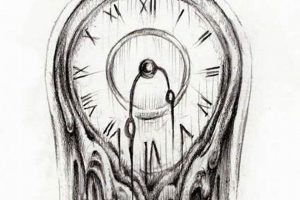Body art inspired by the popular Japanese manga and anime series, One Piece, encompasses a wide range of designs, from iconic symbols like the Straw Hat Pirates’ Jolly Roger to portraits of beloved characters like Monkey D. Luffy or Roronoa Zoro. These designs can vary in complexity, from minimalist line art to intricate, full-color depictions of scenes and battles. For example, a simple depiction of the Going Merry ship’s figurehead could represent adventure and camaraderie, while a detailed portrayal of Luffy using Gear Fourth demonstrates the character’s strength and determination.
Such tattoos offer fans a way to express their passion for the series and its themes of friendship, adventure, and pursuing one’s dreams. The enduring popularity of One Piece provides a wealth of source material for unique and meaningful tattoos, allowing individuals to connect with a global community of fans. Further, the rich visual history of the manga and anime provides a diverse palette of styles and imagery, lending itself to creative interpretations and personal expression. These designs can serve as a constant reminder of the series impact and the values it embodies.
This article will explore various design options, considering factors such as placement, size, and artistic style. Discussions regarding popular characters, symbolic imagery, and narrative depictions will provide readers with comprehensive insight into the possibilities offered by One Piece-themed body art. Practical advice for selecting a reputable tattoo artist and ensuring proper aftercare will also be provided.
1. Character Portraits
Character portraits constitute a significant portion of One Piece tattoo designs. Depicting specific characters allows fans to showcase their affinity for particular personalities and represent the values they embody. From protagonists to antagonists, the vast cast offers a diverse range of options for personalized body art.
- Protagonists
Portraits of central characters like Monkey D. Luffy, Roronoa Zoro, and Nami are popular choices, often representing core themes such as resilience, loyalty, and ambition. These depictions can range from close-up headshots showcasing signature expressions to full-body portrayals capturing iconic poses and attire. For example, a tattoo of Luffy with his signature straw hat conveys a sense of adventure and unwavering optimism.
- Antagonists
While less common, antagonist portraits offer a different perspective, allowing individuals to explore the complexities of the One Piece narrative. Characters like Donquixote Doflamingo or Charlotte Katakuri, with their intricate backstories and motivations, can provide compelling subject matter for tattoos. These designs may symbolize overcoming challenges or appreciating the nuanced portrayal of morality within the series.
- Supporting Characters
Beyond the main figures, the extensive supporting cast offers a plethora of options for unique tattoos. Beloved characters like Tony Tony Chopper or Brook provide opportunities to express appreciation for specific traits or story arcs. A tattoo of Chopper in his Heavy Point form could symbolize hidden strength, while a depiction of Brook playing his violin might represent the enduring power of music and memory.
- Stylistic Interpretations
Character portraits can be rendered in various artistic styles, from realistic depictions to stylized interpretations inspired by traditional Japanese art or contemporary tattoo trends. This allows for a high degree of personalization, ensuring the tattoo reflects individual aesthetic preferences. A minimalist line art portrait of Sanji, for instance, could convey elegance and sophistication, while a bold, traditional Japanese-style tattoo of Trafalgar Law might represent strength and rebellion.
Ultimately, the choice of character and artistic style reflects the individual’s personal connection to the One Piece narrative. These portraits serve as a visual testament to the enduring appeal of these characters and the values they represent within the broader context of the series.
2. Symbolic Imagery
Symbolic imagery plays a crucial role in One Piece tattoos, offering a concise yet powerful way to represent key themes and concepts from the series. These symbols often carry deep meaning for fans, allowing for a more nuanced expression of appreciation than character portraits alone. The selection of specific symbols can reflect personal values, resonate with particular story arcs, or commemorate significant moments within the narrative.
Several recurring symbols lend themselves particularly well to tattoo designs. The Straw Hat Pirates’ Jolly Roger, for example, embodies the crew’s spirit of adventure and rebellion against established authority. Devil Fruits, with their diverse powers and transformations, can symbolize embracing one’s potential or the pursuit of specific goals. Marine symbols, while often representing opposing forces, can also signify justice and order, offering a contrasting perspective within the One Piece universe. Even simple markings like Nami’s tangerine and pinwheel tattoo or Ace’s “ASCE” tattoo hold significant meaning for fans, representing personal connections and poignant moments within the storyline. These visual shorthand elements offer a rich vocabulary for expressing individual interpretations of the series.
Understanding the symbolism within One Piece enhances the design process, allowing for the creation of tattoos that resonate on multiple levels. The deliberate choice of specific symbols allows individuals to craft personalized designs that communicate complex ideas and emotions. This understanding avoids misinterpretation and ensures the chosen imagery accurately reflects the intended message. Ultimately, the use of symbolic imagery enriches the artistic and narrative depth of One Piece tattoos, providing a powerful means of personal expression within the broader context of the series’ themes and mythology.
3. Narrative Scenes
Narrative scenes offer a dynamic approach to One Piece tattoos, allowing individuals to capture and showcase pivotal moments from the series. These scenes, unlike single character portraits or symbolic imagery, encapsulate the storytelling essence of the manga and anime, transforming the body into a canvas for epic battles, emotional reunions, and significant turning points in the narrative.
- Depicting Iconic Moments
Key moments like Luffy ringing the Golden Bell at Skypiea or the Straw Hats’ escape from Enies Lobby provide powerful imagery for tattoos. These scenes, imbued with emotional weight and narrative significance, allow fans to commemorate specific arcs and their impact. The visual representation of these events serves as a personal reminder of the series’ themes and the characters’ growth.
- Showcasing Dynamic Action
One Piece is renowned for its dynamic fight sequences. Translating these action-packed moments into tattoo art presents an opportunity to capture the energy and excitement of the series. A depiction of Luffy using Gear Fourth against Doflamingo, for example, can showcase both the character’s power and the artistic skill of the tattoo artist in rendering movement and intensity.
- Exploring Emotional Resonance
Beyond action, narrative scenes can also capture poignant moments of emotional depth. The farewell between the Going Merry and the Straw Hats, or the reunion of the crew after the time skip, offers opportunities to represent the series’ focus on camaraderie and the enduring power of friendship. These emotionally charged scenes resonate deeply with fans, making them compelling choices for tattoo designs.
- Composition and Placement
Narrative scenes often require larger canvases and careful consideration of placement. The body’s natural contours can be utilized to enhance the flow and impact of the scene, creating a visually striking piece of art. A sprawling battle scene might wrap around a limb, while a smaller, more intimate moment could be placed on the chest or back, ensuring the composition complements the chosen body part.
By encapsulating key moments and conveying complex emotions, narrative scenes transform One Piece tattoos into dynamic storyboards, allowing fans to wear their favorite moments and showcase their deep connection to the series’ rich narrative tapestry.
4. Placement Considerations
Placement plays a crucial role in the overall impact and aesthetic of One Piece tattoos. The chosen location on the body influences not only the visibility of the design but also its interaction with the body’s natural contours and the wearer’s individual anatomy. Careful consideration of placement ensures the tattoo complements the chosen design and maximizes its visual appeal.
Size and complexity of the design significantly influence placement decisions. Large, intricate pieces depicting narrative scenes or detailed character portraits often require broader surfaces like the back, chest, or thighs. Smaller, simpler designs, such as symbolic imagery or minimalist character outlines, offer greater flexibility, lending themselves well to placement on the forearm, wrist, or ankle. The body’s natural curves and musculature can be utilized to enhance the design’s flow and create a more dynamic composition. For instance, a serpentine dragon tattoo might wrap around a bicep, emphasizing the arm’s shape, while a portrait might be positioned on the shoulder blade to utilize the flat surface area. Placement also affects the visibility of the tattoo, allowing individuals to choose whether they prefer a more discreet design or one easily displayed.
Practical considerations further influence placement choices. Certain areas of the body, such as hands and feet, experience more frequent wear and tear, potentially leading to faster fading of the tattoo. Areas with higher nerve density, like ribs or inner arms, might be more sensitive during the tattooing process. Understanding these factors ensures individuals make informed decisions that align with their pain tolerance and desired longevity of the tattoo. Ultimately, effective placement enhances the synergy between the design and the body, resulting in a cohesive and visually striking piece of body art that reflects both the individual’s personal style and their appreciation for the One Piece narrative.
5. Color vs. Black and Gray
The choice between color and black and gray significantly impacts the aesthetic and narrative expression of One Piece tattoos. Color tattoos offer vibrant, eye-catching designs, capturing the energy and dynamism of the series. The diverse color palettes within the One Piece world, from the bright hues of Devil Fruit transformations to the varied landscapes of different islands, provide ample inspiration for colorful and visually striking tattoos. A depiction of a Devil Fruit, for example, would benefit from the use of color to accurately portray its unique appearance and power. Similarly, a tattoo of a character using a specific attack, such as Luffy’s Red Hawk, requires color to effectively convey the visual impact of the technique.
Black and gray tattoos, conversely, offer a classic, timeless appeal, often emphasizing detail and shading over vibrant hues. This approach can create a sense of drama and depth, lending itself well to portraits of serious characters or depictions of somber scenes. A black and gray tattoo of Roronoa Zoro, for example, could emphasize his stoicism and swordsmanship through intricate linework and shading. Similarly, a depiction of a significant loss or a dramatic battle scene could benefit from the use of black and gray to enhance the emotional weight and gravity of the moment.
Ultimately, the decision hinges on personal preference and the specific design elements. Color allows for a more literal interpretation of the source material, while black and gray provides a more stylized and potentially more evocative representation. Careful consideration of both options ensures the chosen palette enhances the narrative intent and artistic vision of the tattoo, resulting in a piece that resonates with the wearer’s individual style and appreciation for the One Piece universe.
Tips for Choosing One Piece Tattoo Designs
Selecting appropriate artwork inspired by the One Piece series requires careful planning. These tips offer guidance for navigating the design process effectively.
Tip 1: Research Thoroughly
Comprehensive research ensures informed decisions. Explore various interpretations of characters, symbols, and scenes within existing fan art and official materials. This process allows individuals to discover diverse artistic styles and identify elements that resonate with personal preferences.
Tip 2: Collaborate with a Skilled Artist
A skilled tattoo artist specializing in the desired style (e.g., anime, Japanese traditional, realism) is crucial for realizing the vision effectively. Open communication and sharing reference images ensures the final product aligns with expectations. Artists experienced in translating two-dimensional artwork into compelling body art provide valuable insights and expertise.
Tip 3: Consider Placement Carefully
Body placement significantly impacts the tattoo’s visual presentation. Larger pieces require ample space, while smaller designs offer greater flexibility. Placement should complement the design and consider the body’s natural contours. Visibility preferences (easily displayed versus more discreet) should also factor into the decision-making process.
Tip 4: Reflect on Personal Meaning
A meaningful connection to the chosen design ensures lasting satisfaction. Select imagery that resonates with personal values or commemorates impactful moments within the series. This thoughtful approach transforms the tattoo into a personal statement beyond mere aesthetic appreciation.
Tip 5: Plan for Long-Term Care
Tattoos require ongoing maintenance. Following proper aftercare instructions, including cleaning and moisturizing, preserves the vibrancy and longevity of the design. Choosing a reputable artist experienced in hygiene and safety protocols minimizes risks and ensures proper healing.
By adhering to these guidelines, individuals can ensure their One Piece tattoo remains a cherished piece of body art reflecting their passion for the series for years to come.
This detailed exploration of design choices, placement strategies, and artistic considerations provides a comprehensive foundation for embarking on the journey of acquiring a One Piece tattoo. The following conclusion will reiterate key takeaways and offer final recommendations for prospective enthusiasts.
Frequently Asked Questions about One Piece Tattoos
This section addresses common inquiries regarding tattoos inspired by the One Piece series, offering practical insights and clarifying potential misconceptions.
Question 1: What are the most popular One Piece tattoo designs?
Portraits of central characters like Monkey D. Luffy, Roronoa Zoro, and Nami remain consistently popular choices. Symbolic imagery, such as the Straw Hat Jolly Roger or specific Devil Fruits, also ranks high in demand. These designs offer recognizable representations of the series and its themes.
Question 2: How much do One Piece tattoos typically cost?
Cost varies based on factors such as size, complexity, artist’s experience, and studio location. Smaller, simpler designs may range from a few hundred dollars, while larger, more intricate pieces can cost significantly more. Consulting with multiple artists allows individuals to obtain accurate quotes and compare pricing.
Question 3: Where is the best placement for a One Piece tattoo?
Optimal placement depends on the specific design and individual preferences. Larger designs suit areas like the back, chest, or thighs. Smaller designs offer more placement flexibility, including forearms, wrists, or ankles. Consider visibility preferences and the body’s natural contours when selecting placement.
Question 4: How painful are One Piece tattoos?
Pain levels vary depending on individual pain tolerance and the tattoo’s location. Areas with thinner skin or higher nerve density tend to be more sensitive. Consulting with the tattoo artist allows for discussion of pain management techniques and appropriate placement considerations.
Question 5: How long does it take for a One Piece tattoo to heal?
Healing typically takes several weeks, with complete healing potentially requiring a few months. Following proper aftercare instructions provided by the tattoo artist is crucial for ensuring proper healing and preventing complications.
Question 6: Can One Piece tattoos be removed or covered up?
Removal is possible through laser treatments, but the process can be costly and time-consuming. Cover-up tattoos offer an alternative, transforming existing designs into new artwork. Consulting with experienced tattoo artists specializing in cover-ups provides viable options and expert guidance.
Careful consideration of these frequently asked questions prepares individuals for the process of acquiring a One Piece tattoo, ensuring a positive and informed experience. This concluding section offers final recommendations for prospective enthusiasts.
This resource aims to assist individuals in choosing a One Piece tattoo that aligns with personal aesthetics and reflects their unique connection to the series.
Conclusion
This exploration of One Piece tattoo ideas has provided a comprehensive overview of the various design options available, ranging from character portraits and symbolic imagery to dynamic narrative scenes. Placement considerations, color palettes, and the importance of collaborating with a skilled artist have been emphasized as crucial elements in the design process. Understanding the significance of personal meaning and long-term care ensures the chosen tattoo remains a cherished piece of body art.
Body art serves as a powerful medium for self-expression, and One Piece, with its rich narrative and diverse cast of characters, offers a wealth of inspiration for meaningful tattoo designs. Careful consideration of the themes, characters, and artistic styles discussed herein empowers enthusiasts to embark on their tattoo journey with confidence and create a lasting tribute to this beloved series.







